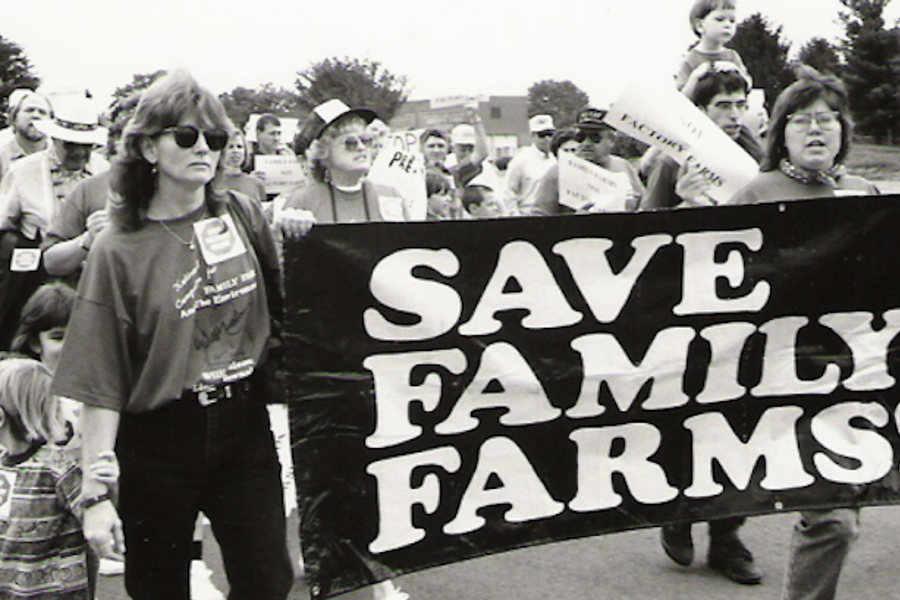Farm Crisis: “Without Immediate Government Action, The Days Of The Small Dairy Farm Are Numbered”
Paul Deaton

Things are bad when the coop sends the suicide hotline number with the milk payment.
Milk prices are currently about $15 per hundred pounds (cwt) while cost of production at family farms is more than $22 per hundredweight. Like so many segments of agriculture, consolidation is driving down costs and small farmers are going out of business.
The National Family Farm Coalition (NFFC) believes the federal government should do something about it and has written a letter to congress and the USDA.
“The nation’s dairy farmers are again in dire straits, just like we were in the 1980s,” Jim Goodman, Wisconsin dairy farmer and board president of National Family Farm Coalition said in a press release. “Proposed safety nets are totally inadequate and without real long-term market reform, dairy farmers will continue to lose their farms. Consumers who care where their milk comes from and policymakers claiming to care about rural America must support these steps to ensure farmers a fair price. Without immediate government action, the days of the small dairy farm are numbered.”
A key component of government action would be to establish a floor for milk pricing at $20 per hundred weight which would provide immediate relief for farmers in debt and unable to pay bills.
“Dairy farmers today are facing no money, no hope, no way to plant spring crops or pay last year’s debts,” says Pennsylvania dairy farmer Brenda Cochran. “Nothing will stop the financial hemorrhage we are facing except a better farm milk price.”
Dairy farmers are coming full circle, sort of.
In 1933, Congress passed the Agricultural Adjustment Act as part of President Franklin Roosevelt’s New Deal. Among other things, the AAA was designed to boost agricultural prices (including milk) by reducing excess production.
“Farm programs in America were originally created as a way to shrink the great mountain of grain, and for many years they helped to do just that,” explains journalist and author Michael Pollan in an article for The New York Times Magazine. “The Roosevelt administration established the nation’s first program of farm support during the Depression, though not, as many people seem to think, to feed a hungry nation…. but to help farmers reeling from a farm depression caused by … collapsing prices due to overproduction.”
Fast forward to President Richard Nixon and his Secretary of Agriculture, Earl Butz, in the 1970s. Facing political pressure due to high food prices, Nixon ordered Butz to do whatever was necessary to drive down the price of food.
“Butz implored America’s farmers to plant their fields ‘fence row to fence row,’” writes Pollan, “and set about dismantling 40 years of farm policy designed to prevent overproduction.”
Food prices have not been high enough to engage consumers ever since. That brings us to today’s dairy crisis.
“I have a hard time imagining how we can conserve farmers without some kind of production controls to curb the overproduction that causes the ag markets to crash,” dairy farmer Francis Thicke wrote on the Practical Farmers of Iowa list serve. “Are American farmers even open to considering production controls?”
The National Family Farm Coalition believes they must be and outlined aspects of a government program to ease oversupply. These include:
- Setting an immediate floor price of $20/cwt for milk used to manufacture dairy products;
- Establishing a milk product purchasing initiative by utilizing U.S. Department of Agriculture’s authority under 7 USCS Section 612c, commonly referred to as Section 32 surplus removal;
- Placing an immediate moratorium on Environmental Quality Incentives Program (EQIP) funding and direct and guaranteed loans for concentrated animal feeding operations (CAFOs);
- Holding hearings on the milk pricing formula and the dairy crisis;
- Implementing a supply management program as outlined in the proposed Federal Milk Marketing Improvement Act of 2011 to stabilize milk production.
It’s clear from watching the Republican controlled federal government that small dairy farmers are on their own. It’s hard for consumers to react when the price of cheese and other dairy products is down and milk sells for less than $2 per gallon. In this scenario, something’s got to give. Unless the federal government steps in with production controls, it will be family dairy farmers.
(“There Is A Family Dairy Farm Crisis” was first published on “Blog for Iowa” and is reposted on Rural America In These Times with permission from the editor. To read the NFFC’s letter to Congress and the USDA in its entirety, please click here.)




